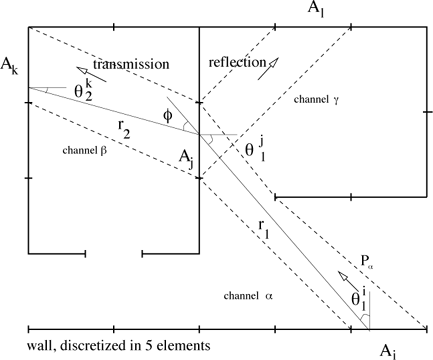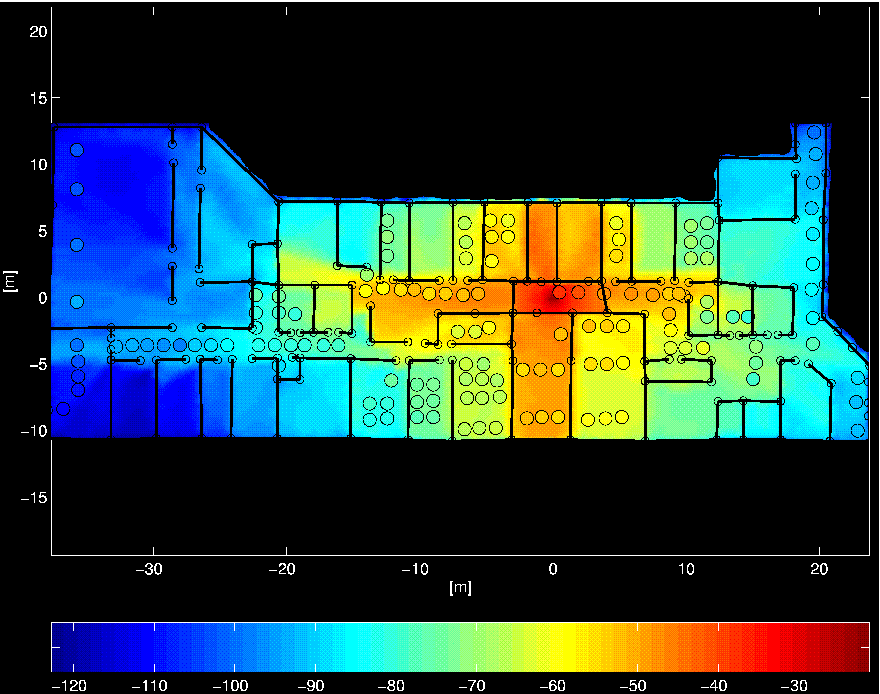Similar numerical algorithms can sometimes be applied in surprisingly different physical applications. Here, nuclear scattering theory inspired a new efficient algorithm to predict the propagation of radio signals through 3D building structures. Free propagation through rooms corresponds to propagators, and Fresnel reflection and transmission coefficients at wall elements correspond to scattering cross sections. In contrast to the conventional ray-tracing algorithms this new approach can handle conservation laws and infinite numbers of reflections in expansions similar to the Lippmann-Schwinger equation. The following summary is adapted from an abstract of the "Diskussionssitzung des FA 9.1 'Messverfahren der Informationstechnik' auf Schloss Reisensburg, Guenzburg/Donau, 03.03-05.03.99":
A new algorithm allows fast indoor propagation prediction for changing transmitter and receiver position

Matthias Liebendoerfer and Ulrich Dersch
Ascom Systec AR&T
Gewerbepark
CH-5506 Maegenwil
www.ascom.ch
For the installation of indoor mobile communication systems the most effective placement of base stations is an important task. It is desirable that computer simulations predict the propagation for various base station configurations in order to reduce trial installations and ensure overall coverage.
We have developed the novel method "Multi Channel Coupling" (MCC) [4] and implemented it in the prediction tool PlaceBase. This method allows a deterministic propagation prediction based on geometric optics, without the need of recalculating valid paths for each trial transmitter or receiver position. Field strength maps can be calculated in immediate response to new transmitter positions.
In the MCC method the propagation environment is discretized into a huge number of free path pieces which we call channels. These channels are at both sides terminated by wall elements. The energy of electromagnetic waves that propagates along these channels is redistributed into adjacent channels at each wall element. Included processes are angle dependent transmission, reflection and absorption according to the Fresnel formula.
Transmitters are treated as sources that radiate into selected channels, receivers are handled as sinks that collect energy from specific channels. The received signal for a specific link between transmitter and receiver is calculated in three steps:
- Feeding of the channels with the transmitter signal (a local process at transmitter position).
- Transportation of the signal through the network of coupled channels.
- Collection of the signal from channels at the receiver positions (again a local process).
The local processes are calculated very efficiently and the coupling coefficients at the vertices of the channel network can be precalculated and stored for reuse in the second step. They depend solely on the geometry of the environment and wall properties. A series expansion of the coupling operator allows the inclusion of an infinite number of reflections. Unlike the ray-tracing approach, the algorithm inherently conserves global energy. This leads to excellent accuracy of the prediction in regions far from the transmitter.
With PlaceBase the installer of e.g. a DECT communication system can drag and drop transmitters in a virtual environment on his laptop. Without delay he will see the consequences of the displacements in an updated field strength map. We demonstrate the alpha-release of the PlaceBase Software and compare its predictions with measurements.
Gallery


The picture above shows a simulation of a floor with offices in two dimensions [3]. The background colour represents the predicted fading-averaged signal power across the floor. It can be compared with the colours enclosed by circles which stand for the measured signal power at the corresponding positions. The measurements have also been fading-averaged. The simulations are based on five different wall types, concrete, plaster, window, conductor, and transparent. As the concrete and plaster walls include complicated iron reinforcements, we have fitted the effective conductivity for these materials to best match the measurement results. As the transmitter radiation is conservatively transported from channel to channel in the MCC approach, no signal power is lost or gained due to neglected fine structure details in the building. This enables accurate far field predictions in a complicated environment.
At right, we show simulation results and measurements from a three-dimensional simulation in two floors [1]. The code handles any three-dimensional configuration that can be composed out of rectangular wall elements. The left column shows data from the ground floor and the right column data from the first floor. At the top is a little sketch of the floor geometry. All measurement locations are indicated with dots. The numbered crosses indicate the transmitter positions. In the lower graphs we show for each transmitter separately the predicted and measured signal in the ground and first floor. The measurement points have been labelled according to ascending predicted signal strength, such that the solid line with predicted values becomes monotonic. The measured values are then shown with connected dots for comparison. We used the same wall properties as in the 2D example above.
Publications and Patent Applications
- M. Liebendoerfer, M. Zehnder, U. Dersch, "Interactive prediction of 3D indoor propagation, Proc. of the International Zuerich Seminar (2000)
- M. Liebendoerfer, Verfahren zur Lokalisierung von Teilnehmern in einem Kommunikationssytem, Patent application EU (1999)
- M. Liebendoerfer, U. Dersch, Multi-Channel Coupling, a new method to predict indoor propagation, IEEE 47th Veh. Techn. Conf., vol 3: 1405 (1997)
- M. Liebendoerfer, Verfahren zum Bestimmen der Uebertragungsqualitaet eines Signals in einem drahtlosen Kommunikationssystem, Patent application EU (1997)
